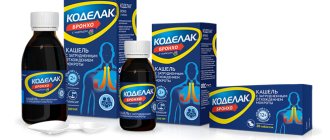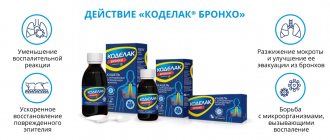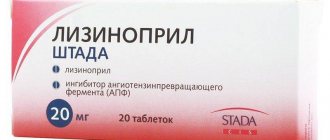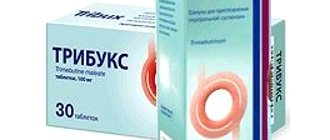Composition of Codelac
1 tablet of Codelac contains codeine (INN - Codeine) - 8 mg, sodium bicarbonate - 200 mg, licorice root in powder form - 200 mg, lanceolate thermopsis herb - 20 mg;
additional substances: potato starch, talc, microcrystalline cellulose. Composition of Codelac Phyto syrup: 5 ml contains codeine phosphate - 4.5 mg, dry thermopsis extract - 0.01 g, thick licorice root extract - 0.2 g, liquid thyme extract - 1 g; additional substances: sorbitol , nipazole , nipagin , water.
pharmachologic effect
The medicine is a combined antitussive drug.
Codeine has an antitussive effect of central origin, reducing the excitability of the cough center.
Thermopsis herb contains alkaloids that increase bronchial secretion and accelerate its evacuation, thereby providing an expectorant effect.
Sodium bicarbonate alkalizes bronchial mucus, reduces the viscosity of sputum, and activates the motility of the bronchial epithelium.
Licorice root has an expectorant effect. It has an antispasmodic effect on smooth muscles and an anti-inflammatory effect.
Thyme herbal extract consists of a mixture of essential oils, which, by enhancing the activity of the ciliated epithelium of the mucous membrane of the upper respiratory tract, increasing the amount of secretion, diluting sputum and accelerating its evacuation, have an expectorant, anti-inflammatory, and bactericidal effect. Additional effects of thyme are also mild antispasmodic and healing.
Codelac Broncho
CODELAC® BRONCHO is a unique1 combination drug for the treatment of wet cough.
Advantages of the drug
- acts both on sputum, facilitating its discharge, and on inflammation in the bronchi, which causes the formation of sputum
- contains, among other things, natural components - extracts of medicinal herbs: thermopsis extract - in KODELAK® BRONCHO tablets
- thyme herb extract – as part of the elixir KODELAK® BRONCHO with thyme
- Ambroxol2,3: thins mucus, reduces viscosity and promotes its removal
- significant reduction in the severity of bronchial inflammation
Advantages of release forms
- 2 forms of release provide the possibility of using the drug in people of different age groups: elixir - in children over 2 years of age and adults;
- tablets - for adults and children over 12 years of age.
- elixir: each bottle is equipped with a polyethylene cap with control of the first opening;
- small tablet size, facilitating the process of taking and swallowing the drug;
Indications for use
- diseases of the respiratory tract with the formation of viscous sputum and difficulty in clearing it: acute and chronic bronchitis
- pneumonia
- chronic obstructive pulmonary disease (COPD)
- bronchiectasis.
The line of over-the-counter cough medications KODELAK® is specially designed taking into account the stages of cough in acute respiratory diseases:
- at the beginning of the disease, at the stage of dry cough, CODELAC® NEO can be used.
- subsequently, for a wet cough, including a cough with difficult sputum discharge, you can use KODELAK® BRONCHO (for children - KODELAK® BRONCHO with thyme).
- during the recovery period, when there is a residual dry or unproductive cough, KODELAK® NEO can be used to alleviate the condition of patients.
Instructions for use of Codelac (Method and dosage)
Codelac tablets are taken orally, 1 tablet 2 to 3 times a day, for several days.
The maximum single dose of codeine for adults is 0.05 g, daily dose is 0.2 g.
In patients with impaired renal function, the interval between taking the drug should be increased, since their elimination of codeine is slower.
The instructions for Codelac Phyto cough syrup determine the daily dose of syrup according to age:
- children 2 - 5 years old - 5 ml;
- from 5 to 8 years, 10 ml;
- 8 – 12 years – 10-15 ml;
- from 12 years old and adults – 15-20 ml.
The dose must be divided into 3 doses. The syrup is taken between meals. Therapy is carried out briefly, over several days.
Codelac Broncho tablets: instructions for use
Where can I buy
Registration number: LSR-008115/08
Trade name: Codelac® Broncho
Dosage form : Tablets
Description
Flat-cylindrical tablets from light cream to creamy yellowish in color with darker and lighter inclusions, with a score and a chamfer.
Composition per tablet
Active ingredients: ambroxol hydrochloride (ambroxol) - 20.0 mg, trisodium salt of glycyrrhizic acid (sodium glycyrrhizinate) - 30.0 mg, dry thermopsis extract - 10.0 mg, sodium bicarbonate - 200.0 mg.
Excipients: potato starch - 84.30 mg, microcrystalline cellulose - 150.10 mg, povidone (polyvinylpyrrolidone, povidone K25) -26.40 mg, talc - 13.00 mg, stearic acid - 5.20 mg, sodium carboxymethyl starch ( sodium starch glycolate) - 11.00 mg.
Pharmacotherapeutic group
Combination expectorant
ATX Code: [R05CA10]
Pharmacological properties
Pharmacodynamics
A combined drug for the treatment of cough, it has a mucolytic and expectorant effect, and also has anti-inflammatory activity.
The action of Codelac® Broncho is due to the pharmacological properties of its components:
Ambroxol has a secretomotor, secretolytic and expectorant effect, normalizes the disturbed ratio of serous and mucous components of sputum, and increases the secretion of surfactant in the alveoli. Reduces the viscosity of sputum and promotes its removal.
Glycyrrhat (glycyrrhizic acid and its salts) has anti-inflammatory and antiviral effects. It has a cytoprotective effect due to its antioxidant and membrane-stabilizing activity. Potentiates the effect of endogenous glucocorticosteroids, providing anti-inflammatory and antiallergic effects. Due to its pronounced anti-inflammatory activity, it helps reduce the inflammatory process in the respiratory tract.
Thermopsis extract has an expectorant effect, having a moderate irritant effect on the receptors of the gastric mucosa, and reflexively increases the secretion of the bronchial glands.
Sodium bicarbonate shifts the pH of bronchial mucus to the alkaline side, reduces the viscosity of sputum, and stimulates the motor function of the ciliated epithelium and bronchioles.
Pharmacokinetics
Ambroxol.
Suction. Ambroxol is characterized by rapid and almost complete absorption from the gastrointestinal tract. Bioavailability is 70-80%. The maximum concentration in blood plasma after oral administration is achieved within 1-3 hours. Plasma protein binding is 80-90%.
Distribution. The transition of ambroxol from the blood to tissues when taken orally occurs quickly. The highest concentrations of the active component of the drug are observed in the lungs. Penetrates the blood-brain barrier, placental barrier, and is excreted in breast milk.
Metabolism. Approximately 30% of an ingested dose undergoes a first pass effect through the liver. Studies on human liver microsomes have shown that CYP3A4 is the predominant isoenzyme responsible for the metabolism of ambroxol. The remainder of ambroxol is metabolized in the liver to inactive metabolites.
Excretion. The half-life (T ½) of ambroxol is about 10 hours. Excreted by the kidneys: 90% in the form of metabolites, 10% unchanged.
Pharmacokinetics in special groups of patients.
No clinically significant effect of age and gender on the pharmacokinetics of ambroxol was found, so there is no basis for dose adjustment based on these characteristics. The clearance of ambroxol in patients with severe liver failure is reduced by 20-40%.
In severe renal failure, T ½ of ambroxol metabolites increases.
Trisodium salt of glycyrrhizic acid (sodium glycyrrhizinate).
After oral administration, in the intestine, under the influence of the enzyme β-glucuronidase, produced by bacteria of normal microflora, an active metabolite is formed from glycyrrhizic acid - β-glycyrrhetic acid, which is absorbed into the systemic circulation. In the blood, β-glycyrrhetic acid binds to albumin and is almost completely transported to the liver. The excretion of β-glycyrrhetic acid occurs predominantly in bile, with residual amounts in urine.
Thermopsis dry extract.
The components of the extract are well absorbed in the gastrointestinal tract. The maximum effect occurs 30-60 minutes after oral administration and lasts for 2-6 hours. They are excreted from the body by the kidneys, mucous membrane of the respiratory tract and bronchial glands.
Sodium bicarbonate.
Well absorbed from the gastrointestinal tract. The maximum effect occurs 30-60 minutes after oral administration and lasts for 2-6 hours. They are excreted from the body by the kidneys, mucous membrane of the respiratory tract and bronchial glands.
Indications for use
Diseases of the respiratory tract with difficulty in sputum discharge: acute and chronic bronchitis, pneumonia, chronic obstructive pulmonary disease (COPD), bronchiectasis.
Contraindications
Hypersensitivity to the components of the drug, pregnancy, lactation, children under 12 years of age.
With caution: liver and/or kidney failure, gastric and duodenal ulcers, bronchial asthma.
Use during pregnancy and breastfeeding
The use of the drug during pregnancy is contraindicated. If it is necessary to use the drug during lactation, breastfeeding should be discontinued.
Directions for use and doses
Inside, during meals. Adults and children over 12 years old: 1 tablet 3 times a day. It is not recommended to use without medical prescription for more than 4-5 days.
Side effect
Allergic reactions. Rarely - weakness, headache, diarrhea, dry mouth and respiratory tract, exanthema, rhinorrhea, constipation, dysuria. With long-term use in high doses - gastralgia, nausea, vomiting.
Overdose
Symptoms: nausea, vomiting, diarrhea, dyspepsia.
Treatment is symptomatic; gastric lavage is advisable in the first 1-2 hours after taking the drug.
Interaction with other drugs
Combined use with antitussive drugs leads to difficulty in sputum discharge while reducing cough.
The drug increases the penetration of antibiotics into the bronchial secretions.
special instructions
Do not combine with antitussives.
Impact on the ability to drive vehicles and machinery
There are no known cases of the drug affecting the ability to drive a car or use machinery. No relevant studies have been conducted.
Release form
Pills.
10 tablets in a blister pack. 1 or 2 blister packs with instructions for use in a cardboard pack.
Storage conditions
Store at a temperature not exceeding 25 °C. Keep out of the reach of children.
Best before date
2 years. After the expiration date, do not use the drug.
Vacation conditions
Over the counter.
Marketing authorization holder/organization receiving consumer complaints
PJSC OTCPharm, Russia, 123317, Moscow, st. Testovskaya, 10
Tel.:+7, Fax
otcpharm.ru
, 305022, Russia, Kursk, st. 2nd Aggregatnaya, 1a/18, tel./fax, www.pharmstd.ru
Interaction
Simultaneous use with drugs that depress the nervous system (sedatives, antihistamines, hypnotics, centrally acting analgesics, antipsychotics, anti-anxiety drugs) is not recommended, since it threatens to increase the sedative effect and suppress the respiratory center.
Chloramphenicol enhances the effect of codeine.
of codeine in large doses can enhance the effect of cardiac glycosides ( digoxin ).
Enveloping and adsorbent agents reduce the absorption of codeine from the gastrointestinal tract.
KODELAK BRONCHO TAB N10
Ambroxol
Suction.
Ambroxol is characterized by rapid and almost complete absorption from the gastrointestinal tract. Bioavailability is 70–80%. The maximum concentration in blood plasma after oral administration is achieved within 1–3 hours. Plasma protein binding is 80–90%.
Distribution.
The transition of ambroxol from the blood to tissues when taken orally occurs quickly. The highest concentrations of the active component of the drug are observed in the lungs. Penetrates the blood-brain barrier, placental barrier, and is excreted in breast milk.
Metabolism.
Approximately 30% of an ingested dose undergoes a first pass effect through the liver. Studies on human liver microsomes have shown that CYP3A4 is the predominant isoenzyme responsible for the metabolism of ambroxol. The remainder of ambroxol is metabolized in the liver to inactive metabolites.
Excretion.
The half-life (T1/2) of ambroxol is about 10 hours. Excreted by the kidneys: 90% in the form of metabolites, 10% unchanged.
Pharmacokinetics in special groups of patients.
No clinically significant effect of age and gender on the pharmacokinetics of ambroxol was found, so there is no basis for dose adjustment based on these characteristics.
The clearance of ambroxol in patients with severe liver failure is reduced by 20–40%.
In severe renal failure, T1/2 of ambroxol metabolites increases.
Sodium glycyrrhizinate (trisodium salt of glycyrrhizic acid)
After oral administration, in the intestine, under the influence of the enzyme β-glucuronidase, produced by bacteria of normal microflora, the active metabolite β-glycyrrhetic acid is formed from glycyrrhizic acid, which is absorbed into the systemic circulation. In the blood, β-glycyrrhetic acid binds to albumin and is almost completely transported to the liver. The excretion of β-glycyrrhetic acid occurs predominantly in bile, with residual amounts in urine.
Thermopsis lanceolata herb extract
The components of the extract are well absorbed in the gastrointestinal tract. The maximum effect occurs 30–60 minutes after oral administration and lasts for 2–6 hours. They are excreted from the body by the kidneys, mucous membrane of the respiratory tract and bronchial glands.
Sodium bicarbonate
Well absorbed from the gastrointestinal tract. The maximum effect occurs 30–60 minutes after oral administration and lasts for 2–6 hours. They are excreted from the body by the kidneys, mucous membrane of the respiratory tract and bronchial glands.
special instructions
Use with great caution in persons with increased intracranial pressure.
Long-term use of the drug can lead to the development of drug dependence .
Do not prescribe simultaneously with mucolytics and expectorants.
Before using antitussive drugs, it is necessary to accurately determine the cause of the cough and, if necessary, use special treatment.
Because the drug with codeine is a dope.
The drug may have a sedative effect; driving is not recommended.
Analogs
Level 4 ATX code matches:
Tussin Plus
Terpincode
Codterpin
Analogues are drugs from the pharmacological group of antitussives: Sinekod , Libexin , Pertussin .
Reviews about Codelac
Numerous reviews of Codelac Phyto indicate that the drug is quite effective. Most patients, having tried all kinds of cough tablets, only received improvement from Codelac. Many mothers leave reviews of Codelac Fito for children as a mild drug, with good tolerability and quick cough relief. Some reviews note the sedative effect as a plus - thanks to this, children sleep better at night.
When choosing treatment, you must always remember what kind of cough Codelac is for - take only for dry cough.
Codelac price, where to buy
The price of Codelac tablets in Russia is 143 rubles, the price of Codelac Phyto syrup is 146 rubles.
- Online pharmacies in RussiaRussia
- Online pharmacies in KazakhstanKazakhstan
ZdravCity
- Codelac Neo cough syrup 100 ml Pharmstandard-Leksredstva OJSC RUB
183 order - Codelac Broncho + ambroxol 20 mg, tablets 10 pcs. JSC Pharmstandard (ICN) Leksredstva Kursk
RUB 137 order
- Codelac Broncho + ambroxol 20 mg, tablets 20 pcs. JSC Pharmstandard (ICN) Leksredstva Kursk
RUB 197 order
- Codelac Neo cough drops 20 mlPharmstandard-Leksredstva OJSC
RUB 282 order
- Codelac Neo cough tablet. 10 pcs. JSC Pharmstandard-UfaVITA
RUB 197 order
Pharmacy Dialogue
- Codelac Broncho tablets No. 20FS.-Leksredstva
210 rub. order
- Codelac Broncho (elixir with thyme 200ml)FS.-Leksredstva
RUB 297 order
- Codelac Neo drops 5mg/ml 20mlFS.-Leksredstva
RUB 298 order
- Codelac Broncho (elixir with thyme 100ml)FS.-Leksredstva
175 rub. order
- Codelac Broncho (elixir with thyme 200ml)FS.-Leksredstva
RUB 295 order
show more
Buy Codelac Neo syrup 1.5 mg/ml 100 ml in pharmacies
Instructions for use Codelac Neo Dosage forms syrup 1.5 mg/ml 100 ml Synonyms Omnitus Sinecode Group Non-narcotic antitussives International nonproprietary name Butamirate Composition Active substance: butamirate citrate - 7.5 mg. Manufacturers Pharmstandard-Leksredstva OJSC (Russia) Pharmacological action Pharmacodynamics. A non-opioid antitussive agent that has a direct effect on the cough center. It has an antitussive, expectorant, moderate bronchodilator and anti-inflammatory effect, improves spirometry (reduces airway resistance) and blood oxygenation. Pharmacokinetics. Suction. After oral administration, the drug is quickly and completely absorbed from the gastrointestinal tract. After taking 150 mg of butamirate, the maximum concentration of the main metabolite (2-phenylbutyric acid) in the blood plasma is reached after approximately 1.5 hours and is 6.4 mcg/ml. Distribution and metabolism. Hydrolysis of butamirate initially to 2-phenylbutyric acid and diethylaminoethoxy-ethanol begins in the blood. These metabolites also have antitussive activity, and, like butamirate, are 95% bound to plasma proteins. This is due to the long half-life of the drug from plasma. 2-phenylbutyric acid is partially metabolized by hydroxylation. When taking the drug again, no accumulation is observed. Excretion. The half-life is 6 hours. All three metabolites are excreted primarily in the urine. Moreover, 2-phenylbutyric acid is mainly excreted in the form associated with glucuronic acid. Side effects From the central nervous system: less than 1% of cases - dizziness, which goes away when the drug is stopped or the dose is reduced. From the digestive system: nausea, diarrhea. Allergic reactions: skin rash, itching. Other: exanthema. Indications for use : Dry cough of any etiology, cough during the preoperative and postoperative period, cough during surgery and bronchoscopy, whooping cough. Contraindications Hypersensitivity to the components of the drug, pregnancy (first trimester), breastfeeding period. Children under 3 years of age. Use of the drug during pregnancy and breastfeeding. Experimental studies did not reveal any undesirable effects of the drug on the fetus. Clinical studies of the safety of the drug have not been conducted, and therefore the drug should not be used in the first trimester of pregnancy. The penetration of the drug into breast milk has not been studied, so administration of the drug during breastfeeding is not recommended. Directions for use and dosage: The syrup should be taken orally before meals. The syrup is prescribed to children: aged 3 to 6 years - 5 ml 3 times a day; from 6 to 12 years - 10 ml 3 times a day; 12 years and older - 15 ml 3 times a day. Adults - 15 ml 4 times a day. When taking the drug, you should use a measuring device. Overdose Symptoms: nausea, vomiting, drowsiness, diarrhea, dizziness, decreased blood pressure, loss of balance. Treatment: activated carbon, saline laxatives, symptomatic therapy (according to indications). Interaction Not noted. Special instructions The drug can be used by patients with diabetes mellitus, since sucrose or glucose is not used as a sweetener. Storage conditions Store out of the reach of children at a temperature not exceeding 25 C.



